Anup Mishra
Reinforcement Learning-Based Policy Optimisation For Heterogeneous Radio Access
Jun 18, 2025Abstract:Flexible and efficient wireless resource sharing across heterogeneous services is a key objective for future wireless networks. In this context, we investigate the performance of a system where latency-constrained internet-of-things (IoT) devices coexist with a broadband user. The base station adopts a grant-free access framework to manage resource allocation, either through orthogonal radio access network (RAN) slicing or by allowing shared access between services. For the IoT users, we propose a reinforcement learning (RL) approach based on double Q-Learning (QL) to optimise their repetition-based transmission strategy, allowing them to adapt to varying levels of interference and meet a predefined latency target. We evaluate the system's performance in terms of the cumulative distribution function of IoT users' latency, as well as the broadband user's throughput and energy efficiency (EE). Our results show that the proposed RL-based access policies significantly enhance the latency performance of IoT users in both RAN Slicing and RAN Sharing scenarios, while preserving desirable broadband throughput and EE. Furthermore, the proposed policies enable RAN Sharing to be energy-efficient at low IoT traffic levels, and RAN Slicing to be favourable under high IoT traffic.
Coexistence of Real-Time Source Reconstruction and Broadband Services Over Wireless Networks
Nov 20, 2024Abstract:Achieving a flexible and efficient sharing of wireless resources among a wide range of novel applications and services is one of the major goals of the sixth-generation of mobile systems (6G). Accordingly, this work investigates the performance of a real-time system that coexists with a broadband service in a frame-based wireless channel. Specifically, we consider real-time remote tracking of an information source, where a device monitors its evolution and sends updates to a base station (BS), which is responsible for real-time source reconstruction and, potentially, remote actuation. To achieve this, the BS employs a grant-free access mechanism to serve the monitoring device together with a broadband user, which share the available wireless resources through orthogonal or non-orthogonal multiple access schemes. We analyse the performance of the system with time-averaged reconstruction error, time-averaged cost of actuation error, and update-delivery cost as performance metrics. Furthermore, we analyse the performance of the broadband user in terms of throughput and energy efficiency. Our results show that an orthogonal resource sharing between the users is beneficial in most cases where the broadband user requires maximum throughput. However, sharing the resources in a non-orthogonal manner leads to a far greater energy efficiency.
Coexistence of Radar and Communication with Rate-Splitting Wireless Access
Nov 20, 2024Abstract:This work investigates the coexistence of sensing and communication functionalities in a base station (BS) serving a communication user in the uplink and simultaneously detecting a radar target with the same frequency resources. To address inter-functionality interference, we employ rate-splitting (RS) at the communication user and successive interference cancellation (SIC) at the joint radar-communication receiver at the BS. This approach is motivated by RS's proven effectiveness in mitigating inter-user interference among communication users. Building on the proposed system model based on RS, we derive inner bounds on performance in terms of ergodic data information rate for communication and ergodic radar estimation information rate for sensing. Additionally, we present a closed-form solution for the optimal power split in RS that maximizes the communication user's performance. The bounds achieved with RS are compared to conventional methods, including spectral isolation and full spectral sharing with SIC. We demonstrate that RS offers a superior performance trade-off between sensing and communication functionalities compared to traditional approaches. Pertinently, while the original concept of RS deals only with digital signals, this work brings forward RS as a general method for including non-orthogonal access for sensing signals. As a consequence, the work done in this paper provides a systematic and parametrized way to effectuate non-orthogonal sensing and communication waveforms.
Transmitter Side Beyond-Diagonal Reconfigurable Intelligent Surface for Massive MIMO Networks
Jul 19, 2023Abstract:This letter focuses on a transmitter or base station (BS) side beyond-diagonal reflecting intelligent surface (BD-RIS) deployment strategy to enhance the spectral efficiency (SE) of a time-division-duplex massive multiple-input multiple-output (MaMIMO) network. In this strategy, the active antenna array utilizes a BD-RIS at the BS to serve multiple users in the downlink. Based on the knowledge of statistical channel state information (CSI), the BD-RIS coefficients matrix is optimized by employing a novel manifold algorithm, and the power control coefficients are then optimized with the objective of maximizing the minimum SE. Through numerical results we illustrate the SE performance of the proposed transmission framework and compare it with that of a conventional MaMIMO transmission for different network settings.
Mitigating Intra-Cell Pilot Contamination in Massive MIMO: A Rate Splitting Approach
Jun 15, 2022



Abstract:Massive MIMO (MaMIMO) has become an integral part of the 5G standard, and is envisioned to be further developed in beyond 5G networks. With a massive number of antennas at the base station (BS), MaMIMO is best equipped to cater prominent use cases of B5G networks such as enhanced mobile broadband (eMBB), ultra-reliable low-latency communications (URLLC) and massive machine-type communications (mMTC) or combinations thereof. However, one of the critical challenges to this pursuit is the sporadic access behaviour of the massive number of devices in practical networks that inevitably leads to the conspicuous pilot contamination problem. Conventional linearly precoded physical layer strategies employed for downlink transmission in time division duplex (TDD) MaMIMO would incur a noticeable spectral efficiency (SE) loss in the presence of this pilot contamination. In this paper, we aim to integrate a robust multiple access and interference management strategy named rate-splitting multiple access (RSMA) with TDD MaMIMO for downlink transmission and investigate its SE performance. We propose a novel downlink transmission framework of RSMA in TDD MaMIMO, devise a precoder design strategy and power allocation schemes to maximize different network utility functions. Numerical results reveal that RSMA is significantly more robust to pilot contamination and always achieves a SE performance that is equal to or better than the conventional linearly precoded MaMIMO transmission strategy.
Rate-Splitting Multiple Access for 6G -- Part I: Principles, Applications and Future Works
May 05, 2022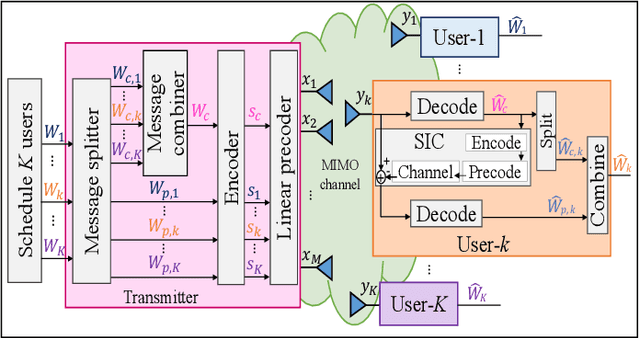
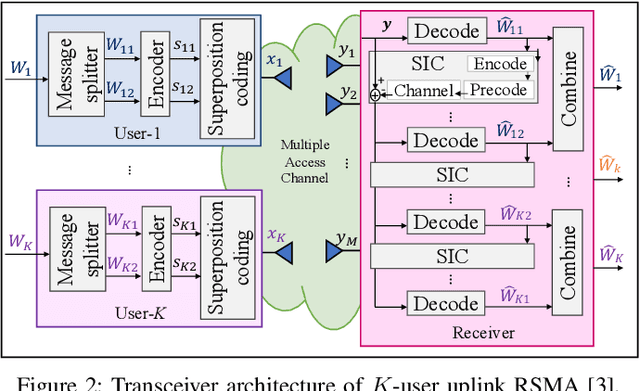
Abstract:This letter is the first part of a three-part tutorial focusing on rate-splitting multiple access (RSMA) for $\mathbf{6}$G. As Part I of the tutorial, the letter presents the basics of RSMA and its applications in light of $\mathbf{6}$G. To begin with, we first delineate the design principle and basic transmission frameworks of downlink and uplink RSMA. We then illustrate the applications of RSMA for addressing the challenges of various potential enabling technologies and use cases, consequently making it a promising next generation multiple access (NGMA) scheme for future networks such as $\mathbf{6}$G and beyond. We briefly discuss the challenges of RSMA and conclude the letter. In continuation of Part I, we will focus on the interplay of RSMA with integrated sensing and communication, and reconfigurable intelligent surfaces, respectively in Part II and Part III of this tutorial.
Rate-Splitting assisted Massive Machine-Type Communications in Cell-Free Massive MIMO
Jan 21, 2022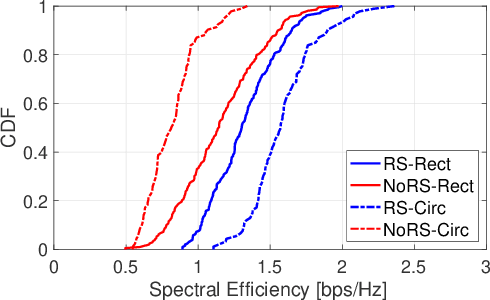
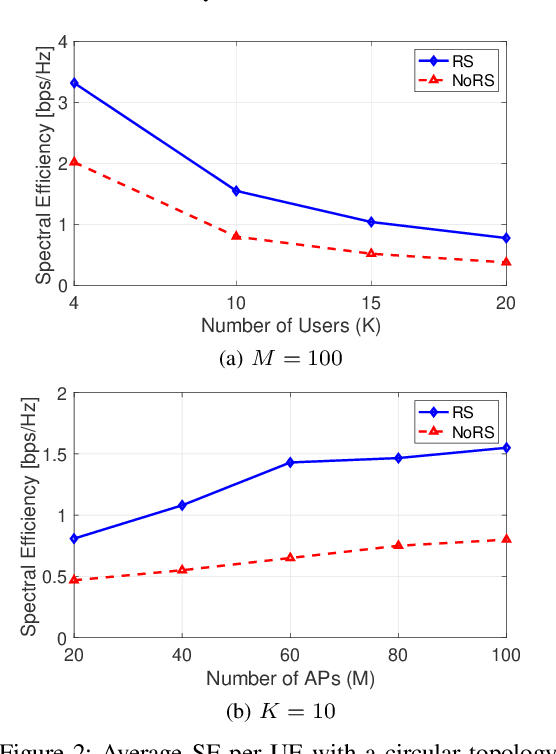
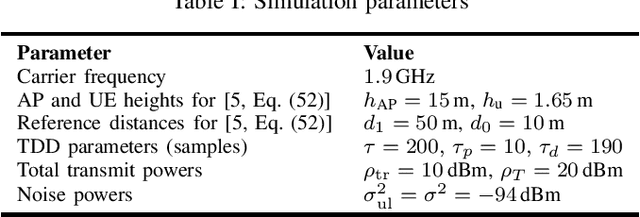
Abstract:This letter focuses on integrating rate-splitting multiple-access (RSMA) with time-division-duplex Cell-free Massive MIMO (multiple-input multiple-output) for massive machine-type communications. Due to the large number of devices, their sporadic access behaviour and limited coherence interval, we assume a random access strategy with all active devices utilizing the same pilot for uplink channel estimation. This gives rise to a highly pilot-contaminated scenario, which inevitably deteriorates channel estimates. Motivated by the robustness of RSMA towards imperfect channel state information, we propose a novel RSMA-assisted downlink transmission framework for cell-free massive MIMO. On the basis of the downlink achievable spectral efficiency of the common and private streams, we devise a heuristic common precoder design and propose a novel max-min power control method for the proposed RSMA-assisted scheme. Numerical results show that RSMA effectively mitigates the effect of pilot contamination in the downlink and achieves a significant performance gain over a conventional cell-free massive MIMO network.
Rate-Splitting Multiple Access for Downlink Multiuser MIMO: Precoder Optimization and PHY-Layer Design
May 16, 2021



Abstract:Rate-Splitting Multiple Access (RSMA) has recently appeared as a powerful and robust multiple access and interference management strategy for downlink Multi-user (MU) multi-antenna communications. In this work, we study the precoder design problem for RSMA scheme in downlink MU systems with both perfect and imperfect Channel State Information at the Transmitter (CSIT) and assess the role and benefits of transmitting multiple common streams. Unlike existing works which have considered single-antenna receivers (Multiple-Input Single-Output--MISO), we propose and extend the RSMA framework for multi-antenna receivers (Multiple-Input Multiple-Output--MIMO) and formulate the precoder optimization problem with the aim of maximizing the Weighted Ergodic Sum-Rate (WESR). Precoder optimization is solved using Sample Average Approximation (SAA) together with the proposed vectorization and Weighted Minimum Mean Square Error (WMMSE) based approach. Achievable sum-Degree of Freedom (DoF) of RSMA is derived for the proposed framework as an increasing function of the number of transmitted common and private streams, which is further validated by the Ergodic Sum Rate (ESR) performance using Monte Carlo simulations. Conventional MU-MIMO based on linear precoders and Non-Orthogonal Multiple Access (NOMA) schemes are considered as baselines. Numerical results show that with imperfect CSIT, the sum-DoF and ESR performance of RSMA is superior than that of the two baselines, and is increasing with the number of transmitted common streams. Moreover, by better managing the interference, RSMA not only has significant ESR gains over baseline schemes but is more robust to CSIT inaccuracies, network loads and user deployments.
 Add to Chrome
Add to Chrome Add to Firefox
Add to Firefox Add to Edge
Add to Edge